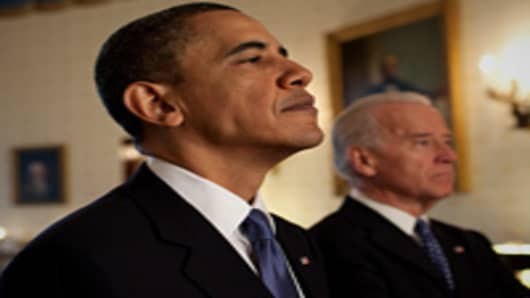But all this discussion of the 14th Amendment ignores something even more fundamental: Obama doesn’t need to issue debt to keep funding all government obligations.
The debt ceiling places a limit on how much debt the Treasury Department may issue. It does not say anything about spending and does not prohibit the government from spending in excess of its revenue.
In other words, on Aug. 3 there’s no legal reason why the Obama administration cannot go right on spending exactly as if the debt ceiling did not exist. Because the debt ceiling is a limitation on borrowing and not on spending.
A lot of people seem to have become confused on this issue because they fundamentally do not understand the economics of government spending. They imagine that government is like a household that must fund itself through generating revenue or taking out loans. You hear politicians use this analogy all the time.
But whatever usefulness this analogy might have, it is badly confusing people in Washington, D.C., when it comes to the debt ceiling debate.
Let’s say that on Aug. 3 the government discovers that its account at the Federal Reserve Bank of New York does not contain enough dollars to fund all of the payments it needs to make. The government could decide that it will just make fewer payments or only pay “important” bills—which is usually described as “prioritizing.”
But the government could also just pay all of its bills, ignoring the fact that the account at the Federal Reserve is empty. So what happens when the government writes checks on an account with no money? Nothing out of the ordinary. Those checks will all clear, with deposits made in the recipients’ bank accounts just as they would have if the account was not underfunded.
Let’s use an example to explain this. Let’s say you are a retiree who collects Social Security payments. When the check comes, you take it to your bank for deposit. The bank submits the check to the Federal Reserve for clearing. The Federal Reserve clears the check by crediting the bank with a deposit in the amount of the check. The bank then credits your account with that amount.
Notice that money has gone into your bank account but it hasn’t come out of any other account. If the government has enough money in its account with the Federal Reserve, the Fed could debit that account.
But if the government doesn’t have enough money in the account, the Fed just doesn’t debit anything at all. It simply creates the credit in the account without a counter-balancing debit anywhere else.
The government is unlike a household because it has the ability to create money simply by creating deposits. This money creation ability means that the government does not need to have raised funds—through taxes or borrowing—before it spends them.
Now, of course, our Federal Reserve is supposed to be independent. In theory, at least, it is possible the Fed could decline to credit accounts with deposits from the empty account of the US Treasury. But it is obliged by law to adopt policies that maximize employment and price stability. Refusing to honor the U.S. Treasury’s checks would hardly seem likely to promote fuller employment and price stability.
Having the Treasury spend regardless of the emptiness of its bank account is not really so different from the way monetary policy is ordinarily conducted. Think about the spectacular growth of the balance sheet of the Federal Reserve during the financial crisis and recession. How was it that the Fed could afford to buy all those bonds it purchased during the two rounds of quantitative easing ?
The answer is that in a system of fiat money, the Fed can afford anything it wants so long as the sellers are willing to accept dollars. If the Fed decides to buy a bond, it can simply credit the account of the bank from which it bought the bond. This expands the money supply by the amount equal to the purchase price of the bond.
There’s no corresponding account from which it is debited. There couldn’t be—if there were there’d be no net monetary creation, just a transfer.
What this means is that there’s no reason that the debt ceiling should constrain government spending. It just constrains government borrowing. Since there are no legal constraints that would block spending, the Obama administration arguably has a legal duty to keep spending as authorized by law. In other words, come Aug. 3—or whenever our spending exceeds the amount of revenue we have—nothing should change at all.
I know it can be very, very difficult to think intelligently about money. It’s not something that is intuitive and is so unique that it’s hard to come up with useful analogies. But maybe over the weekend somebody in Washington will sit down with the President and the Treasury Secretary and explain that this isn’t really a crisis unless they start refusing to pay bills.
_______________________________________________
Questions? Comments? Email us atNetNet@cnbc.com
Follow John on Twitter @ twitter.com/Carney
Follow NetNet on Twitter @ twitter.com/CNBCnetnet
Facebook us @ www.facebook.com/NetNetCNBC



